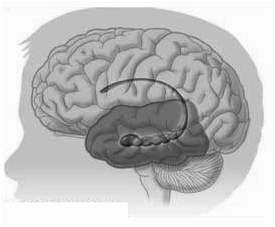A forebrain structure of the temporal lobe, shaped like a seahorse (see figure below), and part of the limbic system, it is thought to be important in emotion, motivation, spatial abilities (e.g., ‘navigation by cognitive maps’) and the consolidation of declarative (but not procedural) memory. Damage to the hippocampus is consistently associated with significant loss of this sort of memory. A salient example is the musician and conductor, Clive Wearing whose right and left hippocampi and part of the left frontal lobe were destroyed by encephalitis arising from a viral infection. Given that the hippocampus is associated with transfer of information from short-term memory to long-term memory, he had the constant experience of “waking up for the very first time”, like living in the permanent present, with nothing making a lasting impression. Thus, it was his declarative memory that was damaged, not his procedural memory. Developmentally, the cytoarchitectonic layers of the hippocampus are formed by 24-25 weeks of gestation in the human. Subsequently, its further maturation is largely a postnatal phenomenon such that, for example, the formation of dendrites and synapses continues for up to five years after birth. Nevertheless, it seems that the newborn has a sufficient number of synaptic connections for memory formation when the intrahippocampal trisynaptic circuit is still forming. Being a relatively late-developing structure, it is susceptible to range of insults such as those associated with preterm birth and fetal alcohol syndrome. The first person to label this brain structure the ‘hippocampus’ was the anatomist Giulio Cesare Aranzi (1529-1589) because he thought it resembled a seahorse.
